
How many skills should I put on my resume and how should I indicate my level of proficiency with those skills? -- from Reddit
If you’re asking, how many skills should I include in my resume?, finding the right number is crucial to making a strong impression.
Generally, including between 5 and 15 relevant skills is ideal, with around 10 skills striking the perfect balance. This allows you to showcase your qualifications clearly without overwhelming the recruiter.
To boost your chances of getting noticed, focus on highlighting skills that are directly relevant to the job description. Combining both hard skills (technical abilities) and soft skills (interpersonal traits) helps present a well-rounded candidate profile.
Additionally, including any certifications or ongoing training related to your skills can demonstrate your commitment to professional development and make you stand out in a competitive job market.
By tailoring your skills section thoughtfully, you’ll increase the likelihood of catching an employer’s eye and moving forward in the hiring process. And here are the 500+ skills for different professions in case you need.
Ideal Number of Skills to Include on Your Resume
A common question among job seekers is, “How many skills should I list on my resume?” The answer is about finding the perfect balance between being thorough and concise. Most effective resumes feature between 5 and 15 relevant skills, with around 10 skills often considered the ideal number for showcasing your qualifications.
Listing too many skills can overwhelm hiring managers and weaken the focus on your most important abilities. On the other hand, including too few skills might not fully represent your expertise or suitability for the role. The goal is to highlight the skills that are most relevant to the specific job description and industry standards.
When choosing which skills to include, tailor your selection based on the role you’re applying for and the expectations within that field. A clear, focused skills section helps your resume stand out and communicates your strengths effectively to recruiters and employers. If you're writing a resume with no job experience, start by reviewing our summary examples for resumes without experience to better align your skill list. Students can also look at these resume summaries for students that show how to blend skills with academic accomplishments.
The key is quality over quantity. A hiring manager doesn’t care if you’ve crammed 30 skills into your resume if half of them aren’t relevant. Instead, focus on skills that directly align with the job description. For example, a graphic designer might list 8-10 skills like Adobe Photoshop, UX design, and typography, while a project manager might include 10-12 skills like Agile methodology, stakeholder communication, and risk management.
Prioritizing Relevant Skills on Your Resume
When it comes to crafting a standout resume, relevance is key. Focusing on the most relevant skills can greatly improve your chances of getting noticed and landing an interview. It’s essential to include skills that directly align with the job description and highlight your core strengths.
The specific industry and role you’re targeting play a major role in deciding which skills to prioritize. Even if some skills are still in development, it’s okay to list them—as long as you’re honest about your proficiency level.
How to Analyze Job Descriptions to Identify Key Skills
Carefully breaking down job descriptions is a powerful way to uncover the skills employers value most. By closely reading and analyzing job postings, you can pinpoint the exact skills that are crucial for the role. This allows you to tailor your resume to mirror those requirements.
Customizing your skills section based on job descriptions boosts your resume’s relevance and makes it easier for recruiters to see why you’re a perfect fit.
Highlighting the Most Important Skills
After identifying key skills from the job posting, prioritize them by relevance and importance. Place the most critical, job-specific skills at the top of your skills section to ensure they catch the recruiter’s eye right away. This strategic ordering demonstrates clearly that you meet the essential qualifications.
By emphasizing relevant skills and organizing them effectively, your resume will stand out in a competitive job market, showcasing your strengths in a way that resonates with hiring managers.
Balancing Hard and Soft Skills on Your Resume
Employers today look for a well-rounded candidate who combines both hard skills and soft skills. Hard skills are specific, teachable abilities—like technical knowledge or software proficiency—while soft skills refer to personal qualities and interpersonal abilities that influence how you work with others. A strong balance of both types is essential for job success and career growth.
Including a mix of hard and soft skills on your resume demonstrates versatility and adaptability. Transferable skills, which can apply across industries and roles, also enhance your employability by showing you can thrive in different environments.
Examples of Hard Skills to Include
Hard skills are measurable and often gained through training or experience. These include technical skills such as programming languages like Python and Java, software expertise in tools like Adobe Photoshop or Excel, and research abilities involving data collection and analysis. Highlighting relevant hard skills with examples from your work experience—and supporting certifications—makes your resume more attractive to recruiters.
Examples of Soft Skills That Matter
Soft skills involve your personal traits and how you interact with others. Important soft skills include effective communication, teamwork, dependability, and problem-solving. These skills are often transferable and valued across all job sectors. Employers especially appreciate candidates who demonstrate strong interpersonal skills like collaboration, conflict resolution, and empathy. Including real-world examples where you successfully applied these skills can help your resume stand out.
By thoughtfully balancing hard and soft skills, you create a comprehensive skills section that appeals to employers and highlights your full potential.
Showcasing Transferable Skills on Your Resume
Transferable skills are vital for job seekers because they demonstrate your ability to succeed across different roles and industries. Highlighting ongoing training and professional development in your resume further shows your commitment to growth and adaptability. This section will help you identify transferable skills and position them effectively to boost your resume’s impact.
Why Transferable Skills Matter
Including transferable skills makes your resume stand out by showcasing versatility and flexibility—qualities highly valued by employers. When you clearly highlight these skills, you prove you can quickly adapt and bring value to any workplace.
How to Identify Transferable Skills
Transferable skills are abilities that apply to a wide range of jobs and industries. For example, data analysis demonstrates critical thinking and technical expertise sought in many fields. Similarly, customer service skills—such as managing difficult situations and resolving complaints—are universally appreciated.
Other transferable skills like research and writing can be showcased by detailing the tools, methods, and documents you’ve worked with. Clearly explaining your experience helps employers understand the breadth of your capabilities.
Positioning Transferable Skills on Your Resume
Present transferable skills with clarity and professionalism. Use precise language and correct grammar to communicate effectively. Tailor how you showcase these skills to fit the specific job and audience, ensuring relevance.
Organizing your transferable skills in a clear, focused section increases your resume’s appeal and highlights your ability to contribute across roles and industries.
Formatting Your Resume’s Skills Section for Maximum Impact
A well-formatted skills section can make a big difference in how recruiters perceive your resume. The most effective formats to showcase your skills are bullet points and tables, both of which improve clarity and make your qualifications easy to scan.
Why Use Bullet Points or Tables
Bullet points are a popular choice because they break down complex information into digestible pieces, making it simple for hiring managers to quickly identify your key skills. This format boosts readability and helps your most relevant qualifications stand out.
Tables offer a visual way to organize skills, especially when you want to display multiple categories side-by-side. Tables can make your resume look clean and professional, allowing recruiters to reference your skills at a glance.
Grouping Similar Skills for Better Organization
To further enhance clarity, group related skills together under clear subheadings like Technical Skills and Soft Skills. Categorizing your skills helps recruiters quickly locate the areas of expertise that matter most for the job.
Using categories not only improves the overall structure of your resume but also makes your skills section more organized and reader-friendly. This strategic layout increases your chances of catching the employer’s attention.
How JobHun Supports Your Resume Writing Process
Creating an effective resume involves more than just listing skills—it requires tailoring your experience to the job and presenting it clearly. JobHun provides helpful tools and insights that make this process easier and more precise.
By analyzing job descriptions and identifying key skills, JobHun helps you focus on the most relevant abilities to include. This ensures your resume aligns with what employers are looking for, balancing both hard and soft skills.
Let’s Get Started on JobHun
To begin, head over to any webpage of JobHun.
See that little 👤 icon at the top right? Give it a click. That’ll take you straight to the resume builder where the magic happens.
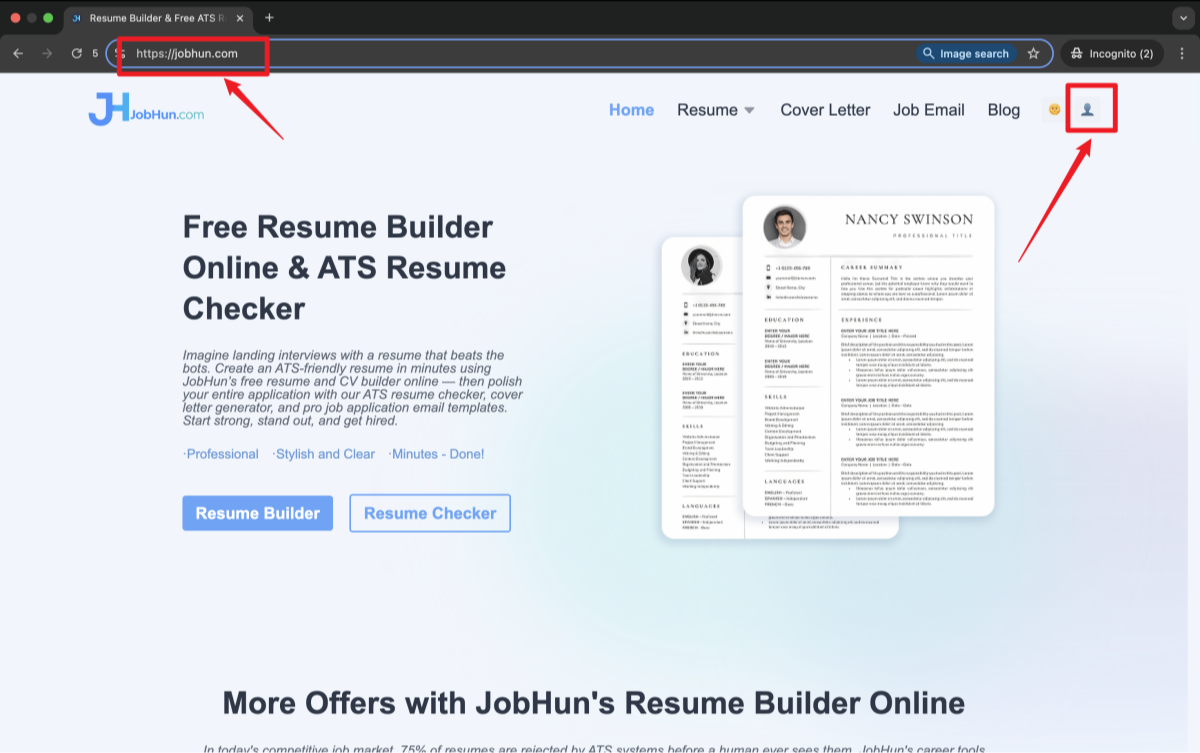
Find Your Way to the Dashboard
You’ll land on the webapp page of JobHun.
Not signed in yet? No worries—you’ll get a prompt.
Click either the “New Resume” button or the “Go to Login” link up top. Both will get you to the sign-in page.
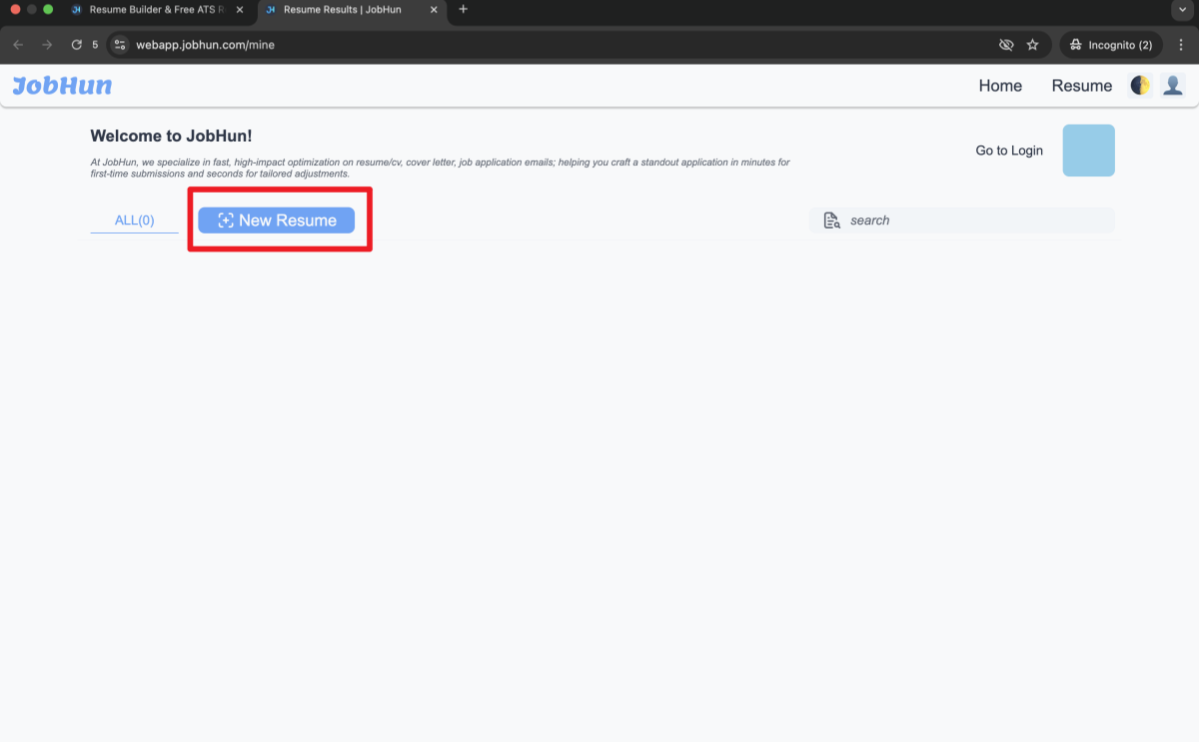
Sign In and Set Up
You’ve got two ways to get in:
- Use Google login to skip the hassle
- Or enter your name, email, and password manually, then hit “Go”
Once you're in, you’ll see your dashboard with all your details.
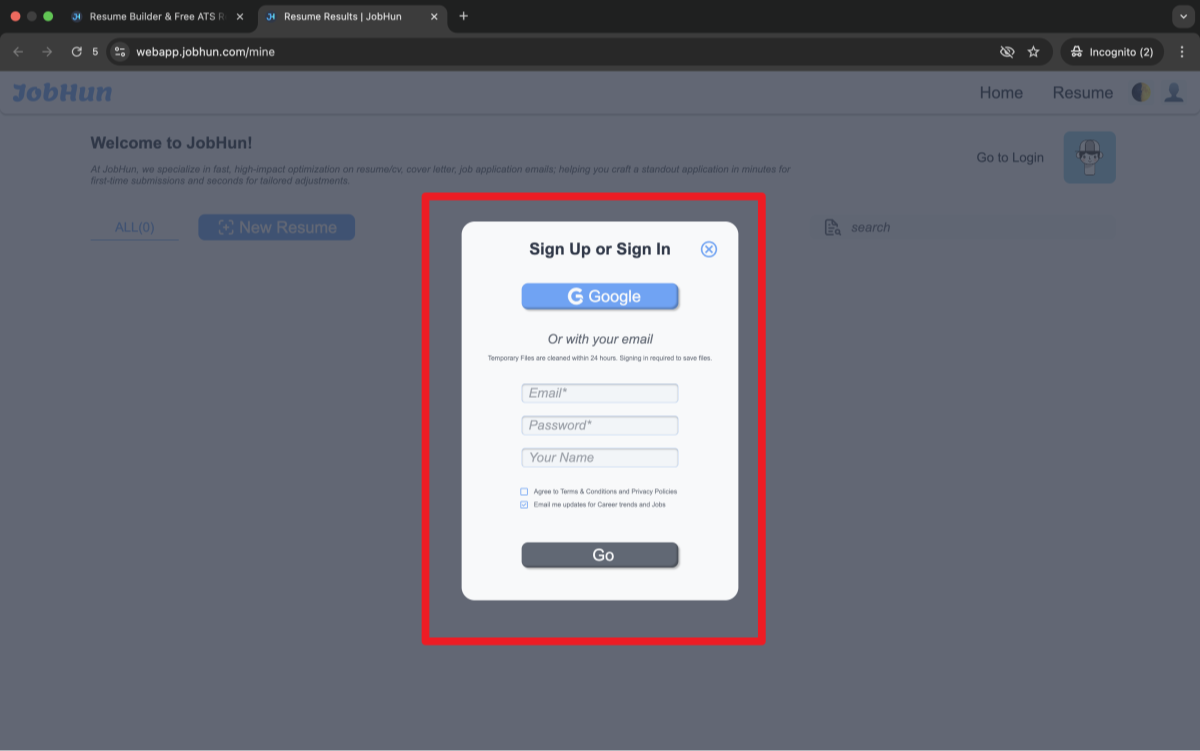
Time to Create a Resume
See your profile in the upper-right? That means you’re in.
Click “New Resume” one more time, and you’re inside the builder.
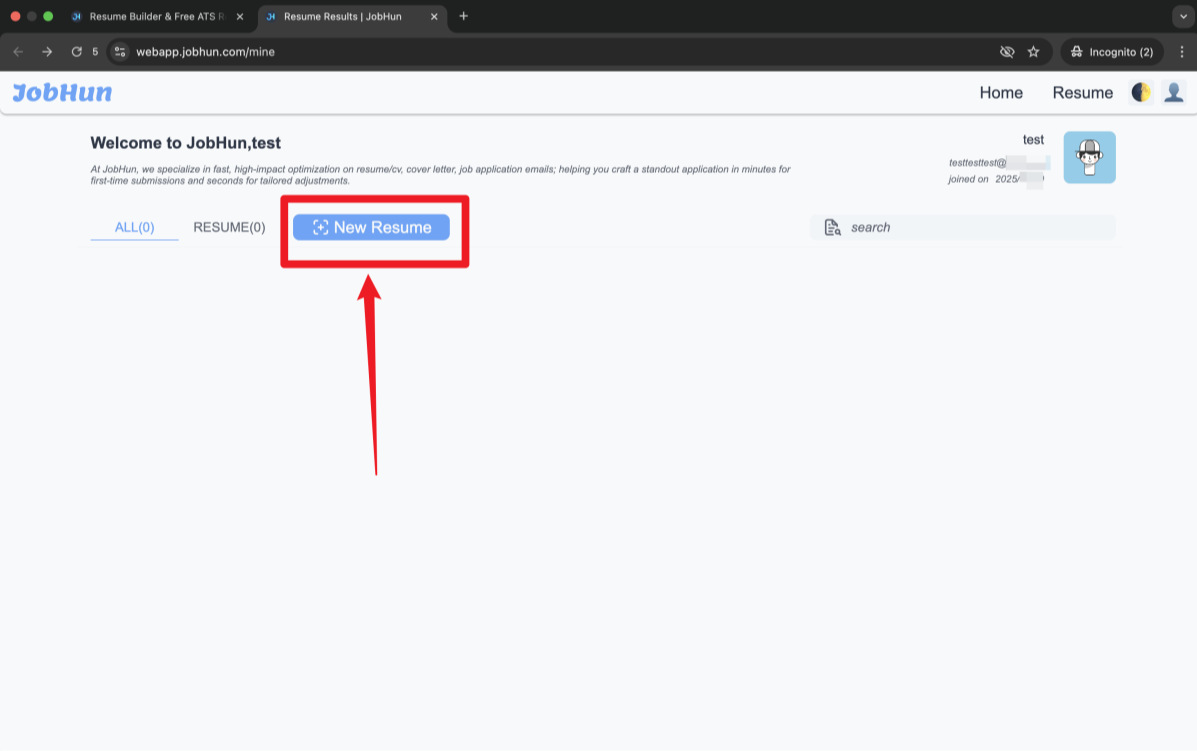
Shape Your Resume Your Way
The builder has two sides:
- On the left: All your editing tools—add experience, reorder sections, update your skills
- On the right: A live preview of your changes
Now you can:
- ✅ Use AI to fill in content
- ✅ Manually refine every detail
- ✅ Customize until it feels just right
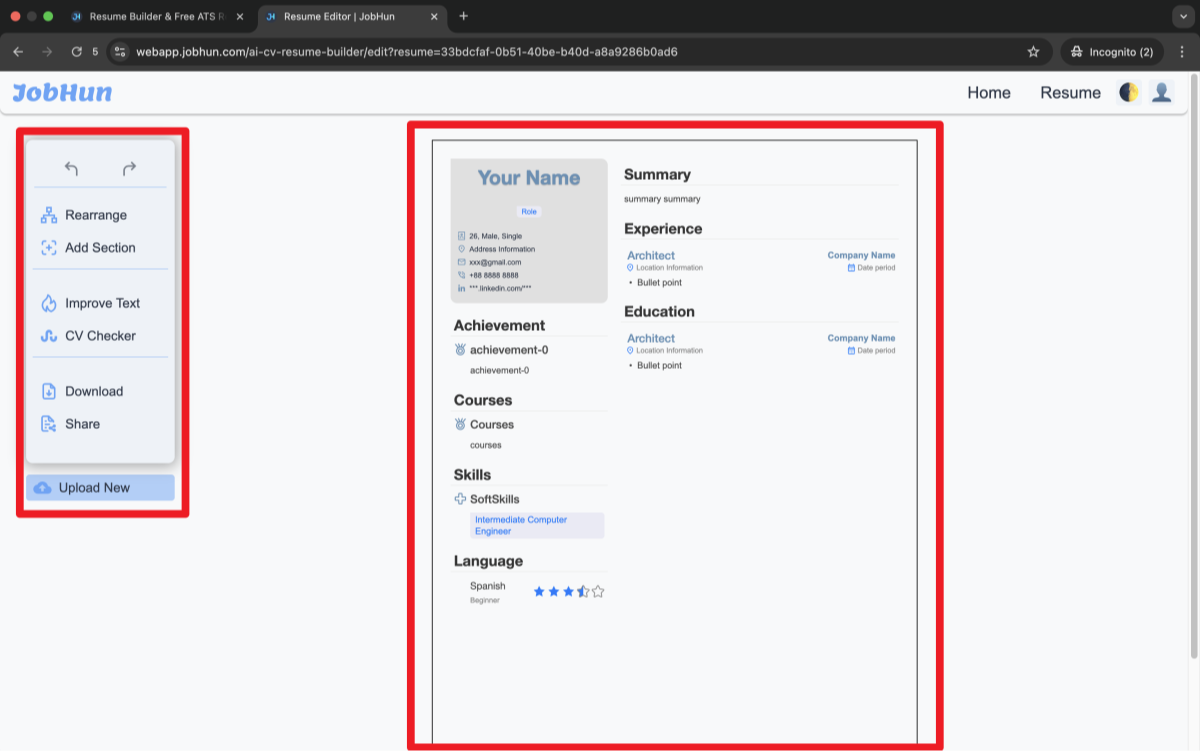
Factors That Influence How Many Skills to Include
Not every job or candidate is the same, so the number of skills you list will depend on a few key factors. Want a quick way to organize your skill section? Use this Google Docs resume tutorial for formatting help. Here’s what to consider:
Industry Type
Some industries demand a broader skill set. For example, tech roles like software engineering often require a mix of technical skills (e.g., Python, JavaScript) and tools (e.g., Git, Docker). In contrast, creative fields like writing or design might focus on fewer, highly specialized skills like SEO writing or Adobe Creative Suite proficiency.
Job Level
Entry-level roles typically require fewer skills since you’re just starting out. A junior marketer might list 6-8 skills like social media management and Google Analytics. Senior roles, however, often call for a wider range to reflect leadership and strategic expertise—think 10-15 skills, including things like budget management or team leadership.
Job Description
The job posting is your roadmap. If the description emphasizes specific skills like “proficiency in Salesforce” or “data analysis with Tableau,” make sure those are front and center. The number of skills you list should reflect the complexity of the role and the employer’s expectations.
By tailoring your skills to these factors, you’ll ensure your resume feels targeted and relevant. Let’s talk about how to choose those skills next.

FAQ about How Many Skills to List on Resume
Here are answers to some common questions about how many skills to list on a resume:
Q: Should I include certifications in my skills section?
A:Certifications are typically best showcased in a dedicated “Certifications” or “Professional Development” section on your resume. However, if a certification directly relates to a critical skill—for example, “AWS Certified Cloud Practitioner”—you can also list it as a skill to reinforce your expertise. This dual approach helps emphasize both your qualifications and practical abilities.
Q: How do I list transferable skills if I’m changing careers?
A: When shifting to a new career path, focus on transferable skills that are valuable across industries, such as project management, communication, problem-solving, or leadership. Highlight these skills by linking them to specific achievements or responsibilities in your work history. For example, describe how your communication skills helped coordinate cross-team projects, showing relevance to your new role.
Q: Is it okay to list skills I’m still learning?
A: It’s best to only include skills on your resume that you feel confident using professionally. If you’re actively learning a new skill like Python or digital marketing, mention it instead in your cover letter or during interviews as part of your growth plan. This shows honesty while demonstrating your motivation to develop relevant abilities.
Q: Should I include soft skills like “team player”?
A: Soft skills are important but should be presented in a professional, specific way. Instead of vague terms like “team player,” use more concrete phrases such as “cross-functional collaboration,” “effective communication,” or “conflict resolution.” Wherever possible, back these up with examples from your experience to give them more weight.
Summary
Deciding how many skills to list on a resume comes down to relevance, balance, and strategy. Aim for 5-15 skills, tailored to the job description, and balance hard and soft skills to showcase your full range of abilities. Format your skills section for clarity, avoid common pitfalls like listing irrelevant skills, and always customize for each job application. By following these tips, you’ll create a resume that grabs attention and lands you that interview. Now go polish that skills section and get ready to shine!





